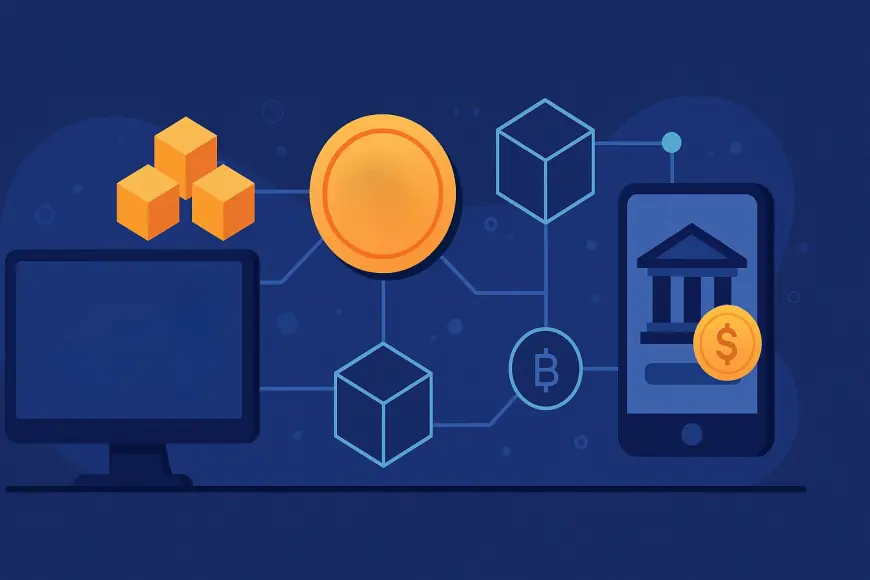How Do You Pick the Right Blockchain for Stable Coin Development?
Learn key factors to choose the best blockchain for stablecoin development, ensuring security, scalability, and long-term project success.

The rise of stablecoins has been one of the most significant developments in the cryptocurrency industry. Offering the benefits of digital assets while maintaining price stability, stablecoins have become essential tools for payments, remittances, decentralized finance (DeFi), and cross-border trade. However, the success of a stablecoin depends heavily on the blockchain it is built on. Choosing the right blockchain is not just a technical decision it impacts transaction costs, security, scalability, regulatory compliance, and user adoption.
In 2025, the competition among blockchain platforms is more intense than ever, with new protocols, Layer-2 solutions, and cross-chain capabilities constantly emerging. For stablecoin developers, this abundance of choice can be both exciting and overwhelming. This article explores the factors that influence blockchain selection, the top platforms for stablecoin development, and how to make an informed decision to ensure your stablecoin’s long-term success.
Understanding the role of blockchain in stablecoin functionality
A blockchain serves as the backbone for any stablecoin, providing the infrastructure for recording transactions, ensuring transparency, and enforcing rules through smart contracts. The choice of blockchain determines how quickly transactions are processed, how much they cost, and how secure the system is against attacks.
Beyond technical performance, the blockchain ecosystem also plays a crucial role in the stablecoin’s adoption. If the chosen blockchain has a large user base, active developer community, and strong integrations with DeFi protocols, the stablecoin is more likely to gain traction quickly. In contrast, building on an isolated or less popular blockchain may limit liquidity, trading volume, and use cases.
Identifying your stablecoin’s purpose and target market
Before choosing a blockchain, it’s important to define the purpose of your stablecoin. Is it intended for cross-border remittances, daily retail payments, institutional settlements, or DeFi collateralization? Each use case demands different blockchain characteristics.
For example, a retail payments stablecoin must prioritize low transaction fees and instant settlement to compete with traditional payment systems. On the other hand, a DeFi-focused stablecoin needs robust smart contract capabilities and deep liquidity pools across decentralized exchanges. By identifying your target market and intended application, you can narrow down blockchains that are best suited for your needs.
Evaluating transaction speed and scalability
Transaction speed is a critical factor for stablecoin usability. High latency can make a stablecoin impractical for real-time transactions, especially in competitive sectors like e-commerce and peer-to-peer payments. Scalability is equally important your chosen blockchain must be capable of handling a growing volume of transactions without significantly increasing fees or slowing down.
Blockchains like Solana and Polygon are known for their high throughput and low latency, making them attractive for large-scale payment solutions. Meanwhile, Layer-2 solutions like Arbitrum and Optimism on Ethereum offer scalability improvements while leveraging Ethereum’s security.
Considering transaction costs for end-users
Transaction fees, or gas costs, have a direct impact on stablecoin adoption. If sending a stablecoin costs several dollars in fees, everyday users and small businesses may be discouraged from using it. This is why many projects are turning to blockchains with lower operational costs.
For example, Binance Smart Chain (BSC) and Tron offer significantly cheaper transaction fees compared to Ethereum, making them attractive for micropayments and remittances. However, lower fees should be balanced against considerations of decentralization and security, as some low-cost blockchains may rely on fewer validators.
Assessing blockchain security and reliability
Security is non-negotiable for stablecoin development. A single vulnerability in the blockchain layer can lead to catastrophic losses and damage investor trust. When evaluating a blockchain, consider its consensus mechanism, track record against hacks, and the robustness of its validator or miner network.
For high-value stablecoins, platforms with proven security, such as Ethereum, are often preferred despite their higher fees. Additionally, stablecoin projects must plan for robust smart contract audits to ensure that vulnerabilities in the token’s code do not become a point of failure.
Evaluating smart contract capabilities
Most stablecoins rely on smart contracts for minting, burning, and transaction management. Therefore, the blockchain must support a mature and well-documented smart contract environment. Ethereum remains the industry leader in this regard, with its extensive developer tools and libraries.
Other blockchains like Avalanche, Cardano, and Polkadot also offer strong smart contract capabilities, though their ecosystems may be smaller. It’s essential to assess whether the blockchain supports the programming languages your team is familiar with and if it offers flexibility for integrating additional features such as automated interest payments or cross-chain functionality.
Checking ecosystem and liquidity support
A blockchain’s ecosystem comprising wallets, exchanges, DeFi protocols, and payment gateways—plays a major role in your stablecoin’s success. The more integrated your blockchain is with existing financial infrastructure, the easier it is for users to adopt your stablecoin.
For example, Ethereum boasts the largest DeFi ecosystem, giving stablecoins built on it immediate access to lending platforms, decentralized exchanges, and liquidity pools. Binance Smart Chain and Polygon also have vibrant ecosystems, while emerging blockchains may require more effort to establish liquidity and integrations.
Considering interoperability and cross-chain compatibility
In 2025, blockchain interoperability has become a priority for stablecoin projects. The ability to operate across multiple blockchains increases your token’s accessibility, liquidity, and use cases. Cross-chain bridges, wrapped tokens, and multi-chain deployment allow stablecoins to serve different user bases without being tied to a single blockchain.
Choosing a blockchain with strong interoperability features such as Cosmos, Polkadot, or Layer-0 solutions like Avalanche Subnets can future-proof your project. This ensures that your stablecoin remains relevant even if user preferences shift toward different blockchain ecosystems.
Analyzing decentralization versus centralization trade-offs
Decentralization ensures trustlessness and censorship resistance, but it can sometimes come at the cost of speed and efficiency. Centralized blockchains may offer faster transaction times and lower fees but may not align with the crypto community’s ethos or user expectations.
Stablecoin developers must decide where their project stands on this spectrum. For regulatory-compliant, institution-focused stablecoins, a more centralized model may be acceptable. For public, open-access stablecoins targeting global users, decentralization may be a higher priority.
Factoring in regulatory compliance
Regulatory frameworks for stablecoins are evolving rapidly. Some jurisdictions may require specific transparency measures, reserve audits, or restrictions on how tokens can be transferred. The blockchain you choose can impact how easily you can comply with these requirements.
For instance, certain enterprise-grade blockchains like Hyperledger Fabric and Stellar offer built-in features that facilitate regulatory compliance, such as transaction monitoring and permissioned access. Public blockchains can also be used, but additional compliance tools may need to be integrated.
Considering developer community and technical support
A strong developer community ensures ongoing updates, bug fixes, and support for the blockchain. It also means more available tools, libraries, and tutorials, which can speed up development. Ethereum, for instance, benefits from one of the largest and most active developer communities in the crypto industry.
Newer blockchains with smaller communities may offer more direct support but can lack the same depth of resources. Before committing to a blockchain, check its documentation quality, active forums, and availability of test networks.
Reviewing blockchain uptime and performance history
Before choosing a blockchain, it’s essential to review its historical uptime and stability. Frequent outages or slowdowns can harm user trust and disrupt transactions. Platforms like Solana, despite offering high throughput, have experienced downtime in the past, which can be a risk for stablecoins requiring 24/7 reliability.
Examining blockchain performance reports, validator activity, and incident history can help determine whether a platform is dependable enough for long-term use.
Popular blockchains for stablecoin development
Several blockchains have emerged as top choices for stablecoin projects in recent years. Ethereum remains the most popular due to its mature ecosystem and widespread adoption. Binance Smart Chain is a strong contender for cost-efficient transactions. Stellar is known for cross-border payment capabilities, while Tron excels in low-cost, high-speed transfers.
Other promising platforms include Solana for its high scalability, Algorand for its efficiency and low fees, and Avalanche for its interoperability and customizable subnets. Layer-2 solutions like Arbitrum and Optimism also offer the advantage of Ethereum compatibility with improved scalability.
Balancing current needs with future scalability
When selecting a blockchain, it’s important to think long-term. While a certain blockchain may meet your needs today, it must also be capable of scaling as your user base and transaction volume grow. This includes considering potential upgrades, protocol improvements, and Layer-2 integrations.
Future-proofing your stablecoin ensures it can adapt to market trends and user demands without needing a disruptive migration to a new blockchain.
Testing before committing to a blockchain
Before finalizing your decision, it’s wise to conduct pilot testing on multiple blockchains. Deploying a test version of your stablecoin allows you to assess transaction speed, costs, smart contract performance, and user experience in real-world conditions.
Many blockchains offer public testnets, enabling you to experiment without incurring high costs. Feedback from testers can provide valuable insights into which platform best meets your goals.
The role of professional blockchain development partners
Partnering with experienced blockchain developers or agencies can streamline the blockchain selection process. Professionals with prior experience in stablecoin development can assess technical requirements, regulatory considerations, and ecosystem compatibility more efficiently.
A reliable development partner can also handle smart contract coding, wallet integration, and exchange listings, ensuring that your stablecoin is built on the most suitable and future-ready platform.
Final thoughts
Choosing the right blockchain for stablecoin development is a multi-layered decision that impacts the success, adoption, and longevity of your project. Factors such as transaction speed, cost, security, scalability, interoperability, and regulatory compliance all play crucial roles in the selection process.
In 2025, with a wide range of blockchain options available, developers have the flexibility to design stablecoins that cater to specific use cases while ensuring performance and compliance. By carefully evaluating your goals, conducting thorough research, and seeking professional guidance, you can choose a blockchain that empowers your stablecoin to thrive in the rapidly evolving digital economy.
What's Your Reaction?
 Like
0
Like
0
 Dislike
0
Dislike
0
 Love
0
Love
0
 Funny
0
Funny
0
 Angry
0
Angry
0
 Sad
0
Sad
0
 Wow
0
Wow
0

















































